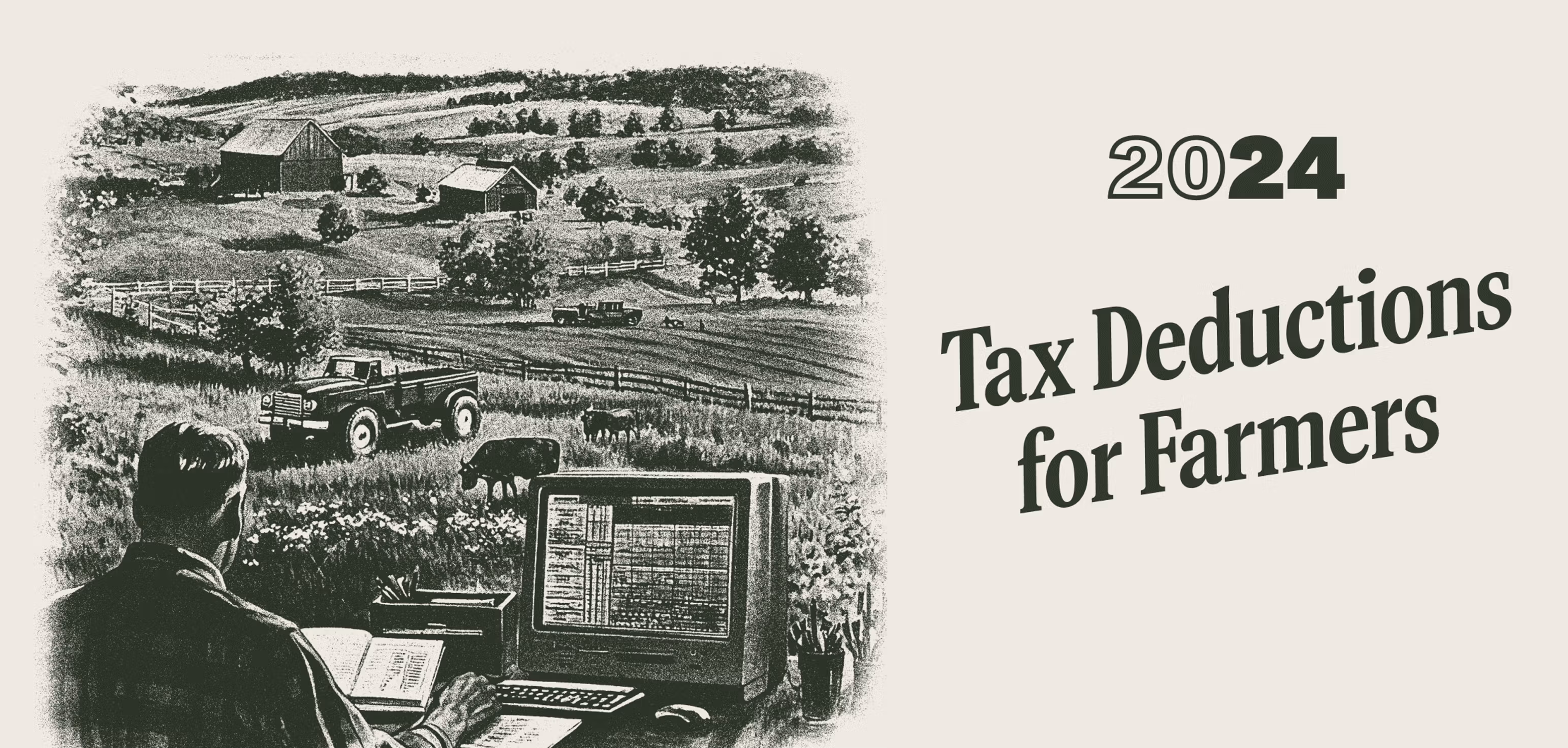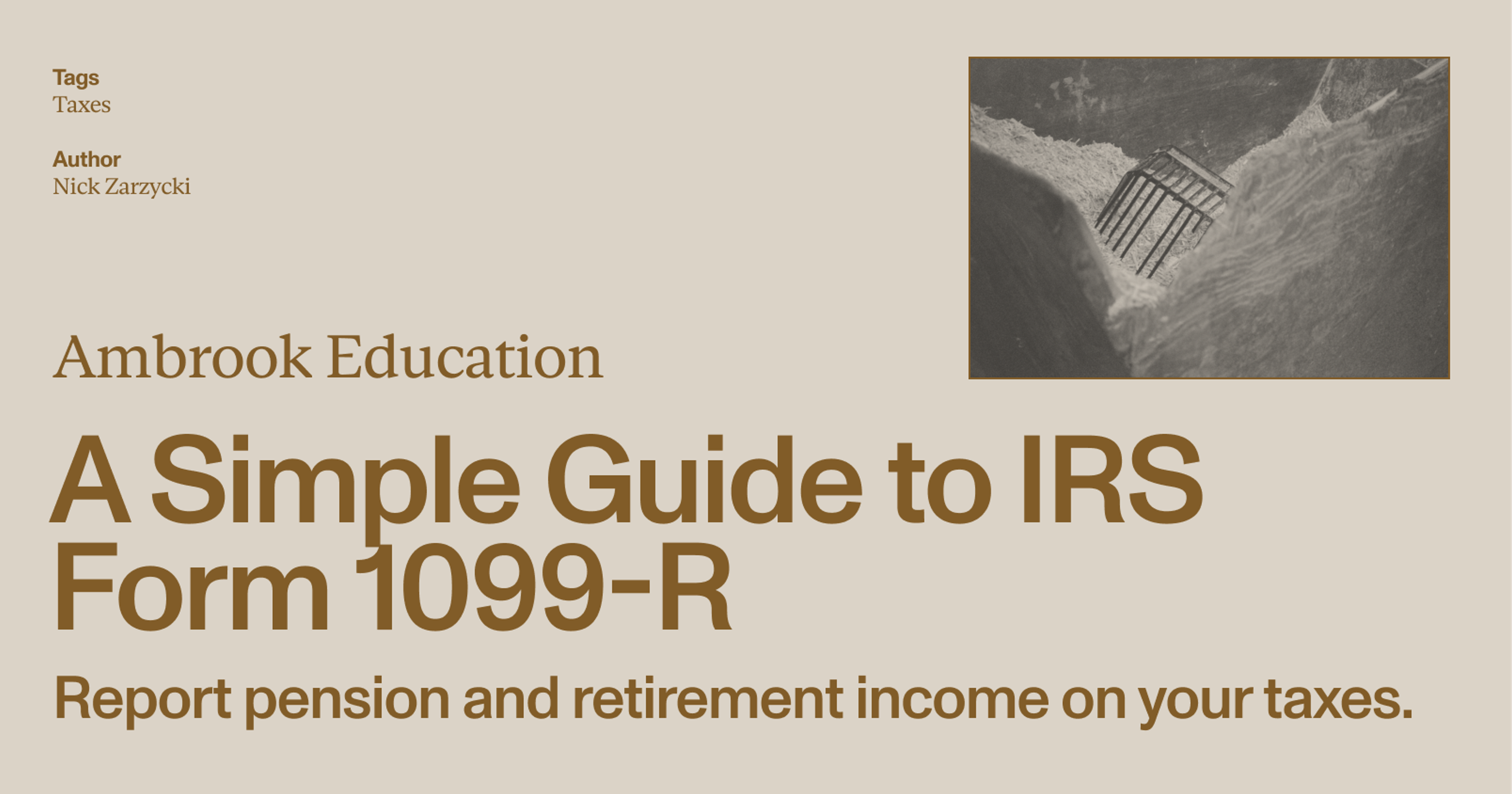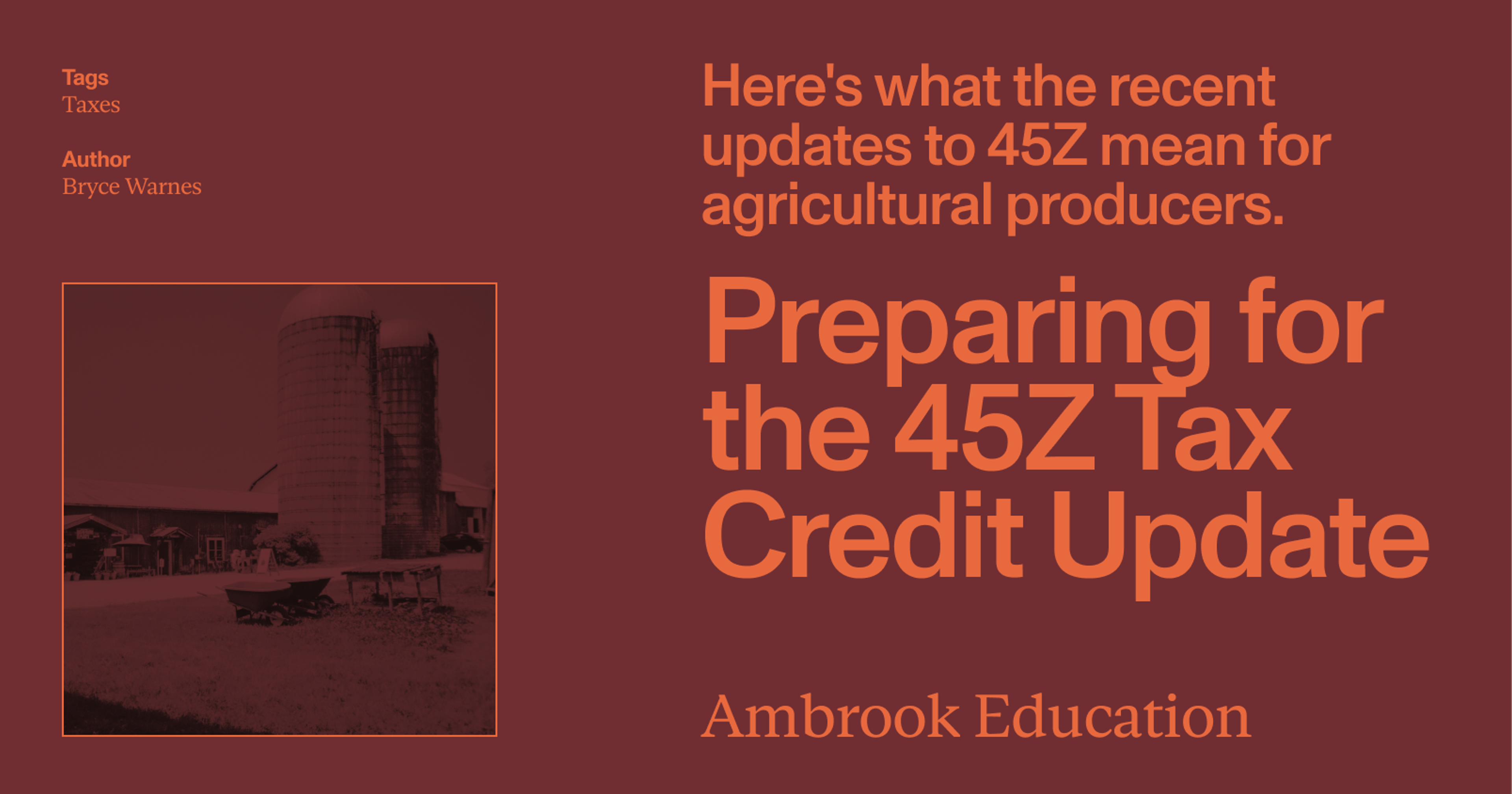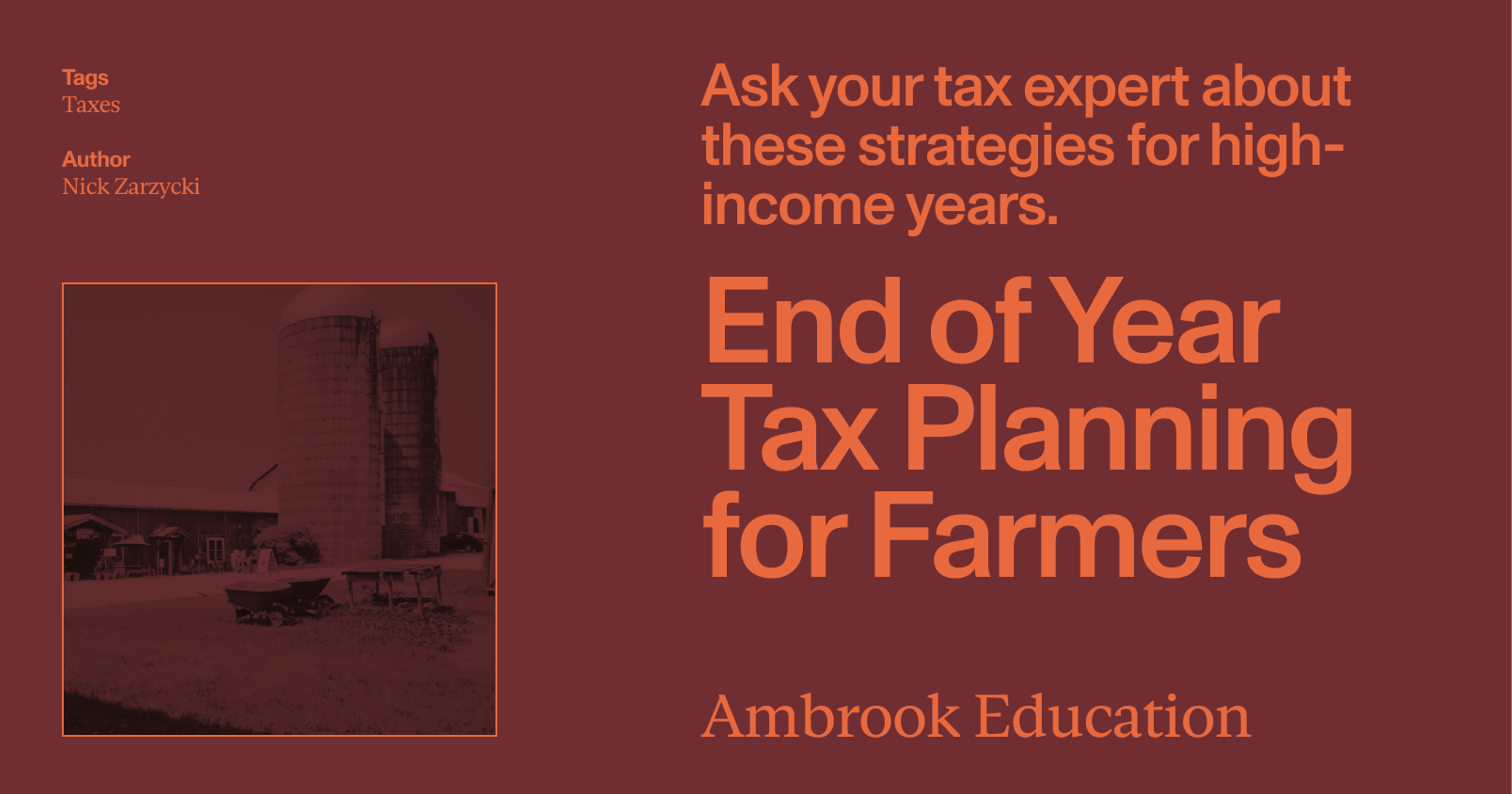A simple guide to maximizing your farm vehicle, repair and maintenance deductions.
So the truck you use for hauling produce needs to be repaired or replaced, and you’re wondering how to maximize your deduction.
Do you buy new or used, and if so what type of vehicle should you buy to get the biggest write-off? Should you lease instead? If you service the vehicle yourself, can you write those costs off?
While most of the costs associated with buying, repairing and maintaining a farm vehicle are deductible if they’re for business use, the rules can get complicated. Here’s what you need to know.
Looking for a different farm tax deduction? Start here.
Deducting Farm Vehicle Expenses
Farmers have two options when deducting their car and truck expenses: the actual cost method and the standard mileage rate (SMR).

1. Actual Cost
As long as the vehicle is used for business purposes, farmers can generally deduct any expenses associated with the use of a farm vehicle, including:
Supplies like oil and gas
Repairs and maintenance
Insurance, car lease payments and loan interest
Depreciation
Fees like license tags, parking and tolls
Local and state vehicle taxes
If you use a vehicle for both personal and business use, you can only deduct the expenses related to business use, and you’ll need to keep detailed vehicle logs.
Provided they’re used for business more than 50% of the time, farmers can also deduct a large percentage of new or used vehicles in the first year they’re placed in service using Section 179, which we’ll return to later.
Related: Audit-Proof Your Vehicles With This IRS Mileage Log Template

2. Standard Mileage Rate
If you haven’t kept detailed enough records to use the actual cost method, you can use the standard mileage rate (SMR) to figure your deduction instead. The standard mileage rate for 2024 is 67 cents per mile, up 1.5 cents from 2023. The standard mileage rate increased to 70 cents per mile for 2025.
Parking, tolls, local and state vehicle taxes and loan interest aren’t included in the SMR and can be deducted on your tax return even if you don’t use the actual cost method.
SMR for 2025:
70 cents/mile
You can’t use SMR if your business operates more than four cars or light trucks, or if you’ve taken the Section 179, Bonus Depreciation, or any other depreciation deduction for the vehicle (see below).
If you use the actual cost method for a vehicle in the first year, you can’t switch to SMR in later years. If you use SMR, you’re allowed to switch to actual cost in later years, but if you do you can only use straight-line depreciation for that vehicle.

The Business Use of a Farm Vehicle Safe Harbor
Coming up with an exact percentage for business mileage can be tricky without detailed vehicle logs. To avoid the extra recordkeeping burden, farmers have a special rule or “safe harbor” called §1.274-6T(b) which allows them to claim 75% of the use of a vehicle for business use without records.
According to the IRS, farmers can only use the safe harbor if they use the vehicle “during most of the normal business day directly in connection with the business of farming.”
This rule can be used in combination with both the actual cost and the SMR method. It must be used in the first year a vehicle comes into use, and you can’t switch to another method in future years if you do.

Section 179 and AFYD for Vehicles
Section 179 allows farmers to deduct a significant portion of the cost of new or used vehicles in the first year that they’re placed in service instead of depreciating them over time, provided the vehicle is used for business more than 50% of the time (you can only deduct the business part). The maximum deduction amount depends on the weight of the vehicle, which we’ll go into in more detail below.
The Section 179 deduction can’t exceed the taxpayer’s total income for that year, and there’s also a total annual limit, which for 2025 is $2,500,000.
Farmers can claim an additional deduction called first-year depreciation (AFYD) or “bonus depreciation,” which allows taxpayers to write off 100% of the cost of a vehicle placed in service between September 27, 2017 and January 1, 2023 and after January 19, 2025.
AFYD began to phase out in 2023, decreasing to 80% for the 2023 calendar year and 60% for 2024, but recent legislation reset Bonus Depreciation to 100% for purchases after January 19, 2025.

Vehicle Limits for Section 179
Four-wheeled vehicles used mainly on public roads with an unloaded gross weight under 6,000 lbs. are considered “light vehicles” by the IRS and the total Section 179 deduction for them is capped.
These limits depend on whether the taxpayer has claimed AFYD for that vehicle, and also change year to year. This chart summarizes the depreciation and Section 179 limits for light vehicles placed in service in 2024:
| Cars (under 6,000 lbs.) | Trucks & Vans (under 6,000 lbs.) | |||
|---|---|---|---|---|
| Tax Year | No AYFD | AFYD | No AFYD | AFYD |
| 2024 | $12,400 | 20,400 | $12,400 | 20,400 |
| 2025 | 19,800 | 19,800 | 19,800 | 19,800 |
| 2026 | 11,900 | 11,900 | 11,900 | 11,900 |
| After 2026 | 7,160 | 7,160 | 7,160 | 7,160 |
For vehicles over 6,000 pounds but under 14,000 pounds, the Section 179 limit for 2024 is $30,500. There are no Section 179 limits for vehicles over 14,000 pounds, extended-bed pickups with a cargo area of at least six feet in interior length and commercial vans with no seating behind the driver’s seat.

Repairs and Maintenance
Expenses related to any vehicle repairs and maintenance like labor, supplies, tools and contractor fees are usually deductible in the year that they’re purchased. Some examples of other activities that qualify as deductible repairs and maintenance include:
Repainting a farm building
Replacing a broken window
Replacing tiles on a roof
Mending a fence
Changing the oil in a farm vehicle
Repairs vs. Improvements
If an expense ‘improves,’ ‘betters,’ or ‘restores’ farm property (i.e. buildings, vehicles, or equipment) in some way, it can’t be deducted and will have to be capitalized and depreciated instead. But the difference between repairs and improvements isn’t always clear. According to the IRS, capital improvements:
Materially add, physically enlarge, expand, or extend the property in some way
Are reasonably expected to materially increase the productivity, efficiency, strength, quality, or output of the property
Restore or rebuild the property to like-new condition at the end of its life
Replace a part or combination of parts that comprise a major component of the property
For example: replacing a few fence posts is a deductible expense, but the cost of replacing an entire fence would be considered a capital improvement.

Adapting property to a new use
Farm expenses might also not be deductible if they adapt farm buildings, vehicles, or equipment to some new or different use.
If a farmer decides to sell some of their land to a real estate developer and pays to clear and re-grade the land for that purpose, for example, the amount paid must be depreciated instead.

De Minimis Safe Harbor Election
A special rule called Section 1.263(a)-1 allows farmers to make what’s called a “safe harbor” election, which allows them to deduct expenses even if they aren’t sure whether they need to be depreciated. This might apply to an expense you aren’t sure qualifies as a repair or an improvement, or to small equipment like chainsaws, bush hogs and tools.
The safe harbor amount for farmers without an applicable financial statement (i.e. they don’t produce financial statements for the SEC, have their financial statements audited by an independent CPA, or produce an income statement for a federal or state government or agency) is $2,500, which means that they can deduct an expense as long as the amount paid does not exceed $2,500 per invoice or item. The amount for farmers with an applicable financial statement is $5,000 per invoice or item.

Labor costs
Most labor costs related to repair and maintenance of farm property are deductible, however farmers can’t deduct wages paid to hire help for the construction of new farm buildings. They also can’t deduct labor costs associated with capital improvements, which must be capitalized.
Farmers also can’t deduct the cost of household work, maintenance work on their home, or any other labor costs related to maintaining or repairing their home, as those are considered non-deductible personal expenses.

Conservation expenses
Farmers can also deduct certain expenses related to soil or water conservation and erosion prevention on land used for farming under Section 175, including land leveling and grading, bush clearing, windbreak planting, construction of irrigation ditches and earthen dams, and more.
These activities must be approved by the USDA’s Natural Resources Conservation Service or an equivalent state body, and farmers can only deduct up to 25% of their annual gross income from farming at a time, but are allowed to carry the excess into future years.

What to know before you start deducting
1. Make sure it’s a business expense
According to the IRS, you can only deduct expenses that are “common” and “necessary” in your line of work. Deducting expenses you use for both business and personal purposes (i.e. vehicles and equipment) often requires extensive recordkeeping in the form of activity logs, and also some proof that they’re directly associated with your business.
2. Know the hobby rules
You can’t deduct any expenses if the IRS determines you’re a non-profit or ‘hobby’ farm. This can happen if you fail to earn a profit in 3 of the last 5 years, which is when the IRS comes in to take a closer look and determine a profit motive. If you fail the profit test, however, you might be able to postpone this process by filing IRS Form 5213.
You can find a list of factors the IRS considers in the ‘Not-for-Profit Farming’ section of the IRS Farm Tax Guide.
3. Separate farming from non-farming
Remember that not all of the income earned on a farm is considered “farming income” for tax purposes.
Processing farm commodities (e.g. wine and cheese-making, butchery, canning, jamming) is not considered farming by the IRS. Providing farming services like custom harvesting, trucking commodities to market, agritourism and running an events space also don’t count.
For more, check out our guide to who is and isn’t considered a farmer for tax purposes by the IRS.

Looking for a different farm tax deduction?
We’ve gathered the most popular farm business deductions into one easy to read guide. Check out the introduction or dive into the relevant section below.
Part 1: Vehicles, Equipment, Repairs and Maintenance
Part 2: Supplies, Fertilizer, Feed and Goods Purchased for Resale
Part 3: Wages, Benefits, Business Travel and Meals
Part 4: Overhead, Fees, Taxes, Office Expenses and Utilities
Supercharge Your Farm Deductions with Ambrook
Ambrook’s category tags correspond directly to each line on Schedule F, making it easy to compare your tax return to your records and saving you hours of work during tax season.
With time-saving bookkeeping automation features, automatically-generated financial reports, streamlined bill pay and invoicing, and other powerful accounting and financial management tools, Ambrook doesn’t just make filing your taxes easy: it takes the guesswork out of running your business. Want to learn more? Schedule a demo today.
This resource is provided for general informational purposes only. It does not constitute professional tax, legal, or accounting advice. The information may not apply to your specific situation. Please consult with a qualified tax professional regarding your individual circumstances before making any tax-related decisions.





